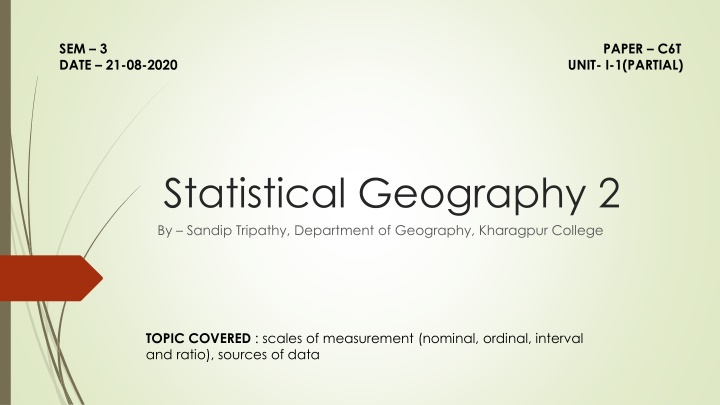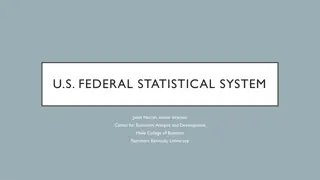Statistical Geography 2
Scales of measurement in statistical geography play a crucial role in quantifying characteristics and phenomena. This covers nominal, ordinal, interval, and ratio scales, each with distinct properties and applications. Nominal scale involves non-numeric labels, while ordinal scale represents ordered values based on feelings or opinions. Interval scale includes true numerical values with no true zero, suitable for applications like Likert scale. Ratio scale is the most precise, with order, interval, and true zero, applicable for measurements like height, weight, and time. Additionally, the sources of data are essential for providing factual information.
Download Presentation

Please find below an Image/Link to download the presentation.
The content on the website is provided AS IS for your information and personal use only. It may not be sold, licensed, or shared on other websites without obtaining consent from the author.If you encounter any issues during the download, it is possible that the publisher has removed the file from their server.
You are allowed to download the files provided on this website for personal or commercial use, subject to the condition that they are used lawfully. All files are the property of their respective owners.
The content on the website is provided AS IS for your information and personal use only. It may not be sold, licensed, or shared on other websites without obtaining consent from the author.
E N D
Presentation Transcript
SEM 3 DATE 21-08-2020 UNIT- I-1(PARTIAL) PAPER C6T Statistical Geography 2 By Sandip Tripathy, Department of Geography, Kharagpur College TOPIC COVERED : scales of measurement (nominal, ordinal, interval and ratio), sources of data
scales of measurement Scale of Measurement Scale means a tool to quantify any object, process, phenomena in terms of characteristics. There are three type of scale to measure Nominal Ordinal Interval Ratio
scales of measurement Nominal Scale Generally Colloquial Nouns which does not have numerical value or such quantification value Example Male or Female, Sources of water could be pond or tube well or tap etc. It is much like Names of Labels Generally Numbers are used only for representation of those Nouns/Labels One of important property is Mutually Exclusive Nature
scales of measurement Ordinal Scale Ordered nature of scale Generally used to measure feeling, opinion, mental condition etc. The difference between the ordered value is not known The numbers are only for ordering representation, not arithmetic relationship between numbers Example How much satisfied after making a purchase from online shopping? Very much , nicely, average, not much, simply not. Also the ordered options are mutually exclusive.
scales of measurement Interval Scale Also have names and order additionally it has true interval between numbers It uses true numerical value of number that means addition, subtraction will works for this kind of scale. But not multiplication and division Because it does not have true zero Example Temperature in Degree Celsius. If 10 degree Celsius is added to another 10 then it comes with 20 degree Celsius. But it does not mean doubles of 10 degree Celsius is 20 degree Celsius. Here 0 degree Celsius is undefined. Uses as Likert Scale Statistical Application Mean, Median, Mode.
scales of measurement Ratio Scale It is true scale which have = order + interval + true zero Here comparing of interval or difference is permissible. All the numerical/arithmatic characteristics are retained. Any type of statistical/mathematical application can be done It has absolute Zero Example Height, weight, time measurement.
Sources of data Sources of Data Data means facts or Information which could be used for reasoning and analysis or calculation. Sources of Data could be of two types Internal Sources(in house data) and External Sources (collected from outside) From the perspective of statistics, there are also two types Primary Data Secondary Data
Sources of data Primary Data When Researcher collect, gather and process directly through interview, survey or community discussion. Generally it is very expensive and time consuming Authenticity of data is guaranteed. Have scope to review and modulate questionnaires according to the pre existing secondary data Results are most authentic and reliable.
Sources of data Secondary Data Pre-existing data, that already been published in any form of media. Sources could be research articles, newspaper, library searches. This data have authenticity and reliability issues if the reputation of conducting authority is not satisfactory. Practises of data suppression are very common. Showcasing the opportunities and limitations of data structures
Quick Brainstorming From which market do you purchase vegetables? Which Type of Data is this? Market A,B,C and D Temperature in Celsius and Fahrenheit Temperature measurement in kelvin Measurement of Nail Length
Have any questions? Ask Here The End Thank you























